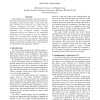Free Online Productivity Tools
i2Speak
i2Symbol
i2OCR
iTex2Img
iWeb2Print
iWeb2Shot
i2Type
iPdf2Split
iPdf2Merge
i2Bopomofo
i2Arabic
i2Style
i2Image
i2PDF
iLatex2Rtf
Sci2ools
ICSE
2004
IEEE-ACM
2004
IEEE-ACM
Architecting in the Face of Uncertainty: An Experience Report
Understanding an application's functional and nonfunctional requirements is normally seen as essential for developing a robust product suited to client needs. This paper describes our experiences in a project that, by necessity, commenced well before concrete client requirements could be known. After a first version of the application was successfully released, emerging requirements forced an evolution of the application architecture. The key reasons for this are explained, along with the architectural strategies and software engineering practices that were adopted. The resulting application architecture is highly flexible, modifiable and scalable, and therefore should provide a solid foundation for the duration of the application's lifetime.
Application Architecture | Concrete Client Requirements | ICSE 2004 | Nonfunctional Requirements | Software Engineering |
| Added | 09 Dec 2009 |
| Updated | 09 Dec 2009 |
| Type | Conference |
| Year | 2004 |
| Where | ICSE |
| Authors | Ian Gorton, Jereme Haack |
Comments (0)

